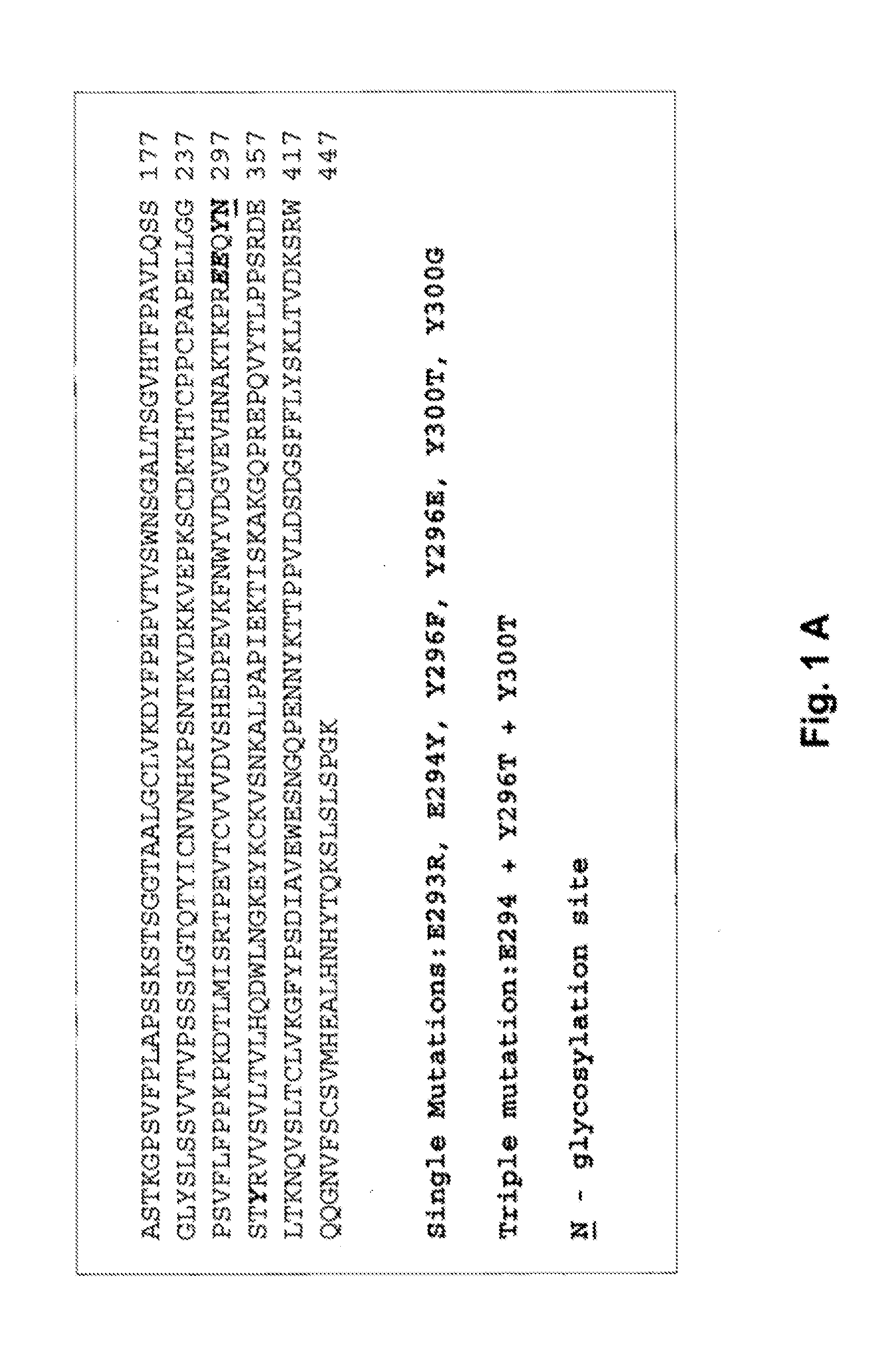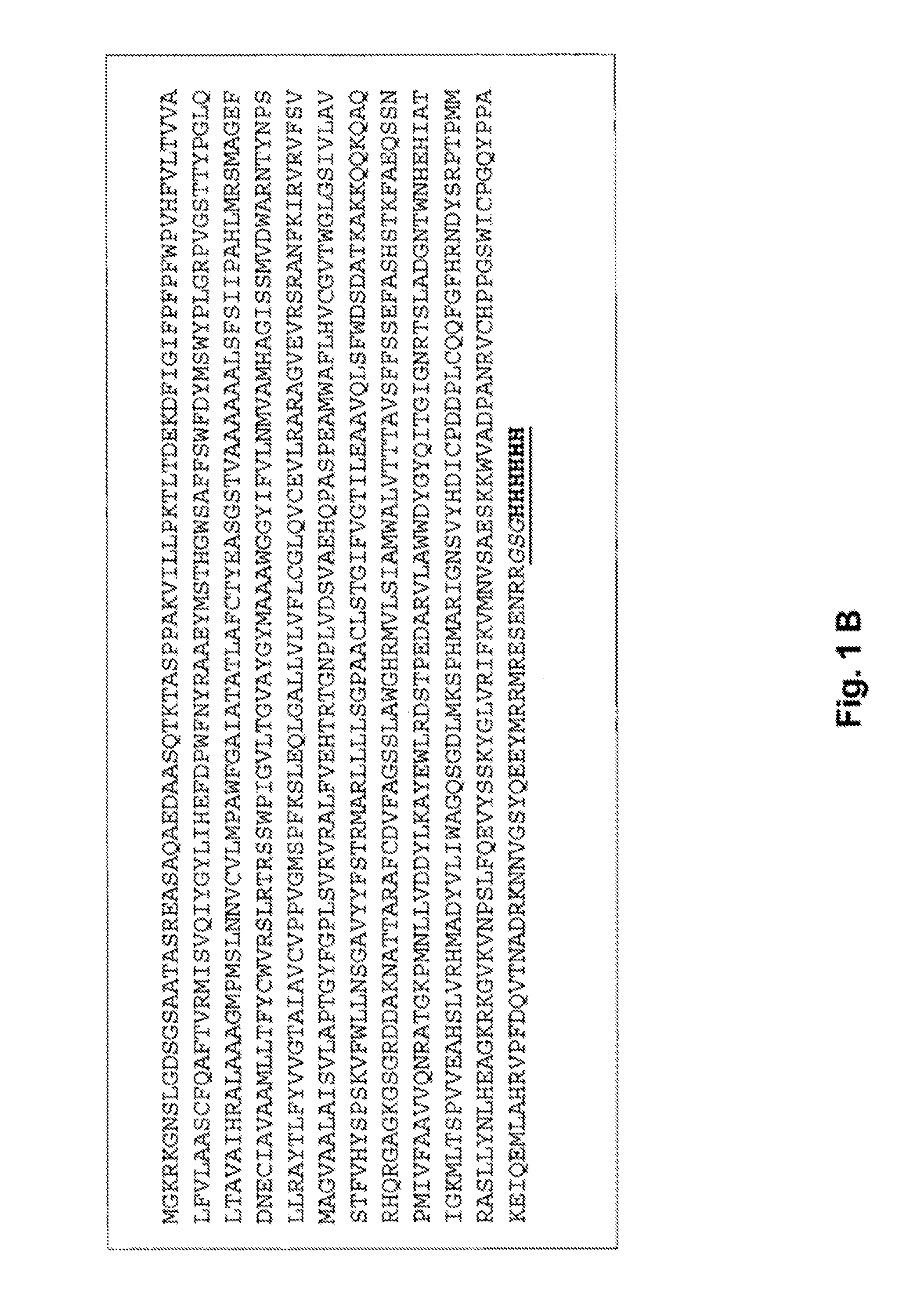Methods of modulating n-glycosylation site occupancy of plant-produced glycoproteins and recombinant glycoproteins
a technology of nglycosylation site and plant-produced glycoprotein, which is applied in the direction of peptides, enzymology, drug compositions, etc., can solve the problems of affecting the biological function of the product, and affecting the biological properties of the produ
- Summary
- Abstract
- Description
- Claims
- Application Information
AI Technical Summary
Benefits of technology
Problems solved by technology
Method used
Image
Examples
example 1
Construct Design
[0126]Based on the MagnICON® technology (Gleba, Y., Klimyuk, V. & Marillonnet, S., 2005, Vaccine 23:2042-2048; Gleba, Y., Klimyuk, V. & Marillonnet, S. 2007, Curr. Opin. Biotechnol. 18:134-141) binary vectors were developed by Icon Genetics using elements from Tobacco Mosaic Virus (TMV) or Potato Virus X (PVX) (Giritch et al., 2006, Proc. Natl. Acad. Sci. USA, 103:14701-14706).
[0127]TMV vectors were built based on the cDNAs of two closely related plant viruses, TVCV (turnip vein clearing virus, Lartey, R. T., Lane, L. C. & Melcher, U., 1994, Arch. Virol., 138:287-298; Lartey, R. T., Voss, T. C. & Melcher, U., 1995, Gene, 166:331-332) and crTMV (a crucifer-infecting tobamovirus, Dorokhov, Y. L., Ivanov, P. A., Novikov, V. K., et al., 1994, FEBS Lett., 350:5-8) which naturally infect solanaceous and cruciferous plants by mechanical transmission. We call the resulting vector ‘TMV-based’, since both parental viruses are tobamoviruses and related to the well-known tobacco...
example 2
Expression, Purification and Glycosylation Analysis of Recombinant Plant-Produced Antibody Having the Variable Regions of Rituximab
[0132]For Ig production, both selected Agrobacterium strains harboring PVX and TMV vectors (Giritch et al., 2006, Proc. Natl. Acad. Sci. USA, 103:14701-14706) were grown separately in LB media with soya peptone (Duchefa Biochemie, Haarlem, The Netherlands) replacing tryptone. Bacterial cultures were grown at 28° C. until the OD600 reaches 3 to 4. Infiltration solution was prepared by mixing and diluting both bacterial cultures in infiltration buffer (10 mM MES, pH 5.5, 10 mM MgSO4) to a defined cell concentration (equivalent to a 500-fold dilution of a culture with OD600 of 1.0). Nicotiana benthamiana plants grown under controlled and standardized conditions were vacuum-infiltrated with the agrobacterial suspension (mixture of two agrobacterial strains harbouring TMV and PVX vectors) and then kept in the growth chambers for 7 days for Ig expression and a...
example 3
Expression, Purification and Qlycosylation Analysis of Recombinant Plant-Produced Trastuzumab
[0136]For production of the recombinant proteins, the selected Agrobacterium strain harboring the TMV-based expression vector is grown in liquid LBS medium with soya peptone (Duchefa Biochemie, Haarlem, The Netherlands) replacing tryptone, and supplemented with 50 μg / mL rifampicin and 50 μg / mL kanamycin. Agrobacterial cultures are grown at 28° C. until OD600 reaches 2 to 4. Infiltration solution is prepared by diluting the agrobacterial culture in infiltration buffer (10 mM MES, pH 5.5, 10 mM MgSO4) to a defined cell concentration (equivalent to a 200-fold dilution of a culture with OD600 of 1.0).
[0137]About 4 to 10 Nicotiana benthamiana plants, grown under controlled and standardized conditions for 6-8 weeks, were vacuum-infiltrated with the agrobacterial infiltration solution and then kept in the greenhouse for 6-8 days for expression and accumulation of the recombinant protein. Plant leav...
PUM
| Property | Measurement | Unit |
|---|---|---|
| OD | aaaaa | aaaaa |
| OD | aaaaa | aaaaa |
| concentration | aaaaa | aaaaa |
Abstract
- (a) the amino acid residue at position +3 is selected from Thr, Ser, Gly, Leu, Ile, Val and Met; or
- (b) the amino acid residue at position −1 is selected from Glu and Asp.
Description
Claims
Application Information
 Login to view more
Login to view more - R&D Engineer
- R&D Manager
- IP Professional
- Industry Leading Data Capabilities
- Powerful AI technology
- Patent DNA Extraction
Browse by: Latest US Patents, China's latest patents, Technical Efficacy Thesaurus, Application Domain, Technology Topic.
© 2024 PatSnap. All rights reserved.Legal|Privacy policy|Modern Slavery Act Transparency Statement|Sitemap



